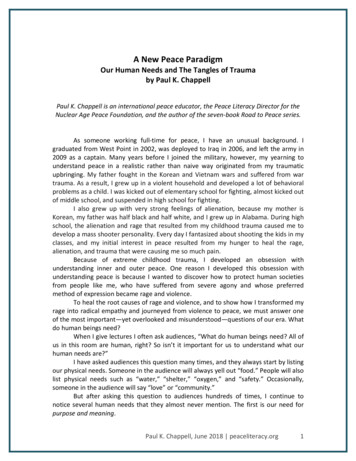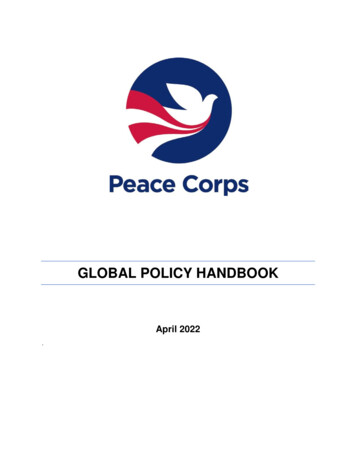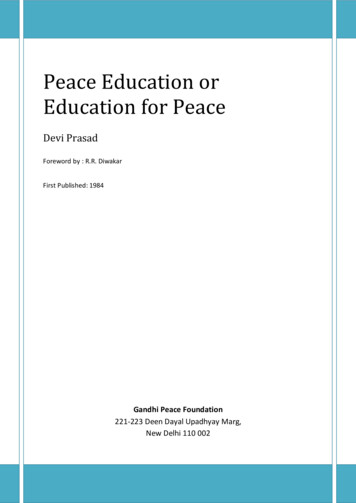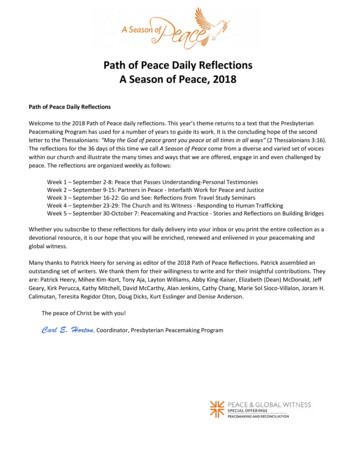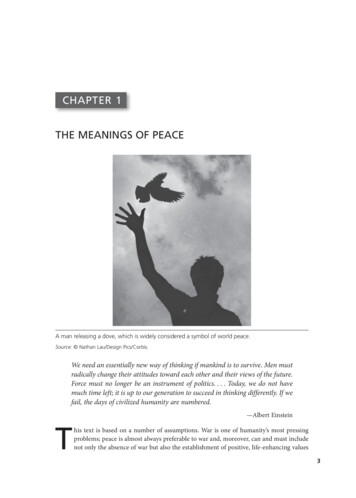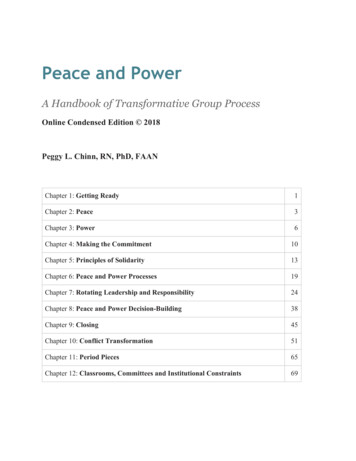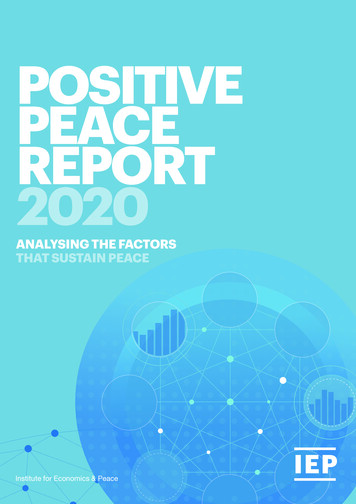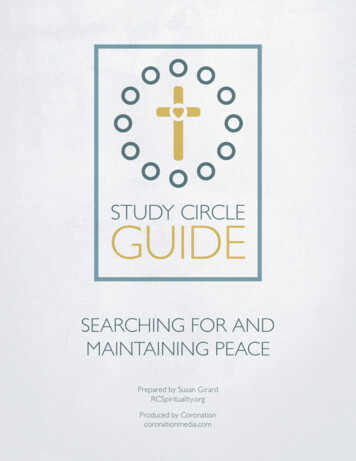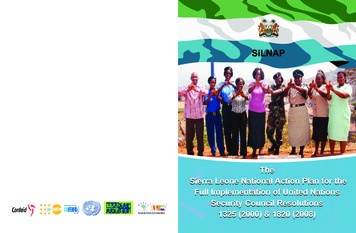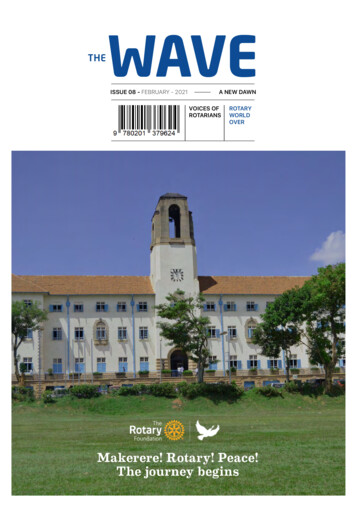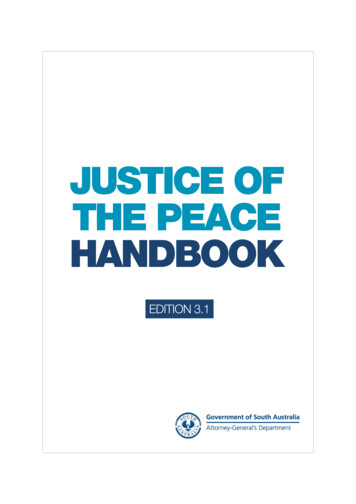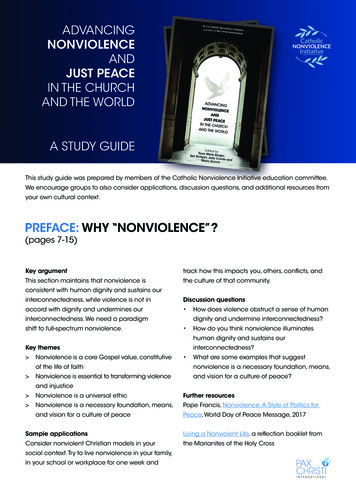
Transcription
ADVANCINGNONVIOLENCEANDJUST PEACEIN THE CHURCHAND THE WORLDA STUDY GUIDEThis study guide was prepared by members of the Catholic Nonviolence Initiative education committee.We encourage groups to also consider applications, discussion questions, and additional resources fromyour own cultural context.PREFACE: WHY “NONVIOLENCE”?(pages 7-15)Key argumenttrack how this impacts you, others, conflicts, andThis section maintains that nonviolence isthe culture of that community.consistent with human dignity and sustains ourinterconnectedness, while violence is not inDiscussion questionsaccord with dignity and undermines our interconnectedness. We need a paradigmshift to full-spectrum nonviolence.How does violence obstruct a sense of humandignity and undermine interconnectedness? How do you think nonviolence illuminateshuman dignity and sustains ourKey themes Nonviolence is a core Gospel value, constitutiveinterconnectedness? What are some examples that suggestof the life of faithnonviolence is a necessary foundation, means,Nonviolence is essential to transforming violenceand vision for a culture of peace?and injustice Nonviolence is a universal ethicFurther resources Nonviolence is a necessary foundation, means,Pope Francis, Nonviolence: A Style of Politics forand vision for a culture of peacePeace, World Day of Peace Message, 2017Sample applicationsLiving a Nonviolent Life, a reflection booklet fromConsider nonviolent Christian models in yourthe Marianites of the Holy Crosssocial context. Try to live nonviolence in your family,in your school or workplace for one week and
PART I: RETURNING TO NONVIOLENCEINTRODUCTION(pages 17-28)Key argument(protests, strike action, boycotts) to engage withNonviolence is the basis of Christian tradition,oppressive structures, research to expandwhich inspires a recommitment to the centrality ofnonviolence, empathic listening, engaging inGospel nonviolence as a universal ethic.self-empathy, speaking out when one identifiesinjustice, nonviolent communication,Key themesdecision-making processes, dialogue, and restorative circles.Nonviolence is a core value of the GospeloNonviolence is a way of life and aspiritualityDiscussion questionsoNonviolence provides strategies for engaging with direct and structuralviolence a culture of peace rooted in integral ecology? Growing momentum for nonviolence inthe ChurchooVatican and Pax Christi InternationalHow can nonviolence support us in creatingWhat means can we use to promote thespirituality of nonviolence? In what ways can the Church promotenonviolence as a universal ethic?conferences promoting nonviolence haveinspired deeper conversationsFurther resourceson nonviolence, publications, andCatholic Nonviolence Initiative, a project of Paxcurricula to promote nonviolenceChristi International, provides lists of educationalPope Francis’ continuous call forresources, documents, and other materials:nonviolence through his ces/writings, and interviews Reaffirming the nonviolent way of JesusMarshall Rosenberg, Nonviolent Communication:oA Language of Life, PuddleDancer, 2015oJesus’ death and resurrection are at thecentre of Gospel nonviolenceFostering aculture of peace through nonviolenceGene Sharp, The Politics of Nonviolent Action,Christians and people of all faiths havePorter Sargent, 1973, pages 114, 348, 466discovered the power of nonviolenceSample applicationsBreaking cycles of violence through nonviolence(no retaliation and love of one’s enemies)mediation of personal, interpersonal andintergroup conflicts, using nonviolent action
PART I: RETURNING TO NONVIOLENCEA SIGN OF THE TIMES: THE SPREADOF NONVIOLENCE(pages 29–62) A sign of the times: The spread of nonviolenceSample applications Nonviolence in action: ContemporaryExplore, through intergenerational conversations,Catholic experiencean understanding of community conflict andSeven stories: Contemporary examples ofviolence and responses to it. Identify links betweenCatholic nonviolent responses to violencereligious identity and violent nationalism. How doNonviolence: A force more powerful thanChristian values of reconciliation, forgiveness, loveviolenceof enemy impinge on this? Key argumentInvestigate the role of radio, television, socialVatican II urged all people of goodwill to see andmedia in generating conversations betweenrespond to the ‘signs of the times’. Today we live‘enemies’ and exploring responses to community/with a crisis of violence which is structural andcommercial violence. How might the ‘binding’institutional, and which impinges on people and(addressing negative, destructive forces),the planet. Violence will not answer the crisis of‘bonding’ (helping to articulate a vision, whereour time: climate change, poverty, migration, thepeople want to go), ‘bridging’ (enabling opposingpandemic of COVID-19. At the same time thesides to come together) approach be applied to people of God and parts of the institutionalyour context?Church offer experiences of nonviolence in action,generating hope and contributing to the teachingDiscussion questionsof the Church on nonviolence. There are many signs that the people of God/our Church is well placed in using its resources,Key themesspace, skills, personnel to grow and nourish Violence is identified as being:active nonviolence. How do the examples Non-militarised and structuraloffered in the seven stories relate to your own Militarisedexperiences? How might you be able to build Militarised commercialon this?It is not only war, but also widespread and What do you make of the idea of bishops/thesystemicChurch as institution/well-known figures in aNonviolent approaches include bothcommunity contributing to the ‘moral reserve’obstructive (intervenes, seeks to break cyclesof that community – ‘putting its body’ intoof violence) and constructive (empowering,public actions, identifying with those whoproactive, builds and strengthens community)experience violence? Where have you seenstrategies and methodssuch responses in your own context?Because our churches globally are embeddedin communities, they are well placed to drawupon and build on the knowledge andresources of communities AND bring theirinternational experiences and knowledgeto situations of violence and conflict
PART I: RETURNING TO NONVIOLENCEA SIGN OF THE TIMES: THE SPREADOF NONVIOLENCE(pages 29–62)Further resourcesPlanning for nonviolence, a video produced by Tom Eddington on behalf of Pax Christi International(12 minutes)Nonviolence in action, a video produced by Tom Eddington on behalf of Pax Christi International(14 minutes)Maria Stephan, How domestic civic movements could reshape U.S. foreign policy, Just Security, February2021Pope Francis, Good politics at the service of peace, World Peace Day Message, 2019Gene Sharp, 198 methods of nonviolent action, Albert Einstein Institution
PART I: RETURNING TO NONVIOLENCEA SIGN OF THE TIMES: THE SPREADOF NONVIOLENCE(pages 62-73) Looking pernicious, multidimensionalSample applicationsviolence in the eyeIt is important to continually challenge militaryTwo particular concerns: Women andmodels of security and budgets/spending prioritiescreation– a budget is the measure of where the heart is.Renewing the Church’s commitment toWhen analysing what is happening in our world,Gospel nonviolencemake the connections between poverty, climatechange, war and militarism. Create spaces whereKey argumentwomen can articulate their experiences of violenceGod’s all-inclusive love for the world is underminedand share their responses to violence. What can beby a culture of violence that dehumanises andlearned from this? Learn from grassroots commu-destroys. The all-consuming, relentless nature ofnities who seek to protect themselves/others/themodern warfare has been consistently challengedearth using Jesus’ third way of active nonviolence.by the church from popes to national conferencesof bishops and the people of God. Jesus’ thirdDiscussion questionsway of challenging violence with love, courage, In Fratelli Tutti (258) Pope Francis says: ‘We cancreativity and sacrifice is taught and embraced byno longer think of war as a solution, becausecommunities around the world.its risks will probably always be greater thanits supposed benefits [It] is very difficultKey themesnowadays to invoke the rational criteria The aggressive development and promotion ofelaborated in earlier centuries to speak ofmilitary technologies is driving conflict – movingthe possibility of a “just war”’. How do we helpit from the traditional battlefields of war to civilianour Church/local communities explore thepopulationsimplications of this for the economy andInternal conflicts, the fear of terrorism and theour engagement in the world? rise of popular civil movements have become What are the ways in which you/your group/focal points for state and military violence –parish can share and learn from the nonviolentfewer wars but greater violenceapproaches offered in the seven stories andThe use of sexual violence as a tactic andsubsequent stories on pages 71-73?consequence of war exacerbates the vulnerability of women and girls in contextsFurther resourcesof conflict and warPaul Rogers and Geoff Tansy, A century withoutWars and the development of militarywar needed to survive environmental threats,technologies have a devastating impact onOpen democracy, February 2021the environment The drive to privatise natural resources suchExtracts from Fratelli Tutti speak to these themes:as water and extractives, fed by greed and No. 36, communityunthinking consumption, are a form of No. 54, hopeviolence to communities and the earth Nos. 121–126, war
PART II: FOUNDATIONS OF NONVIOLENCETHE VOICE OF THE CHURCH ONNONVIOLENCE(pages 75-92)Key argumentBeginning with Vatican II until today, ChurchDiscussion questionsteaching documents especially pronouncements How can our reading of Church teachingfrom the Popes have elaborated more clearly thedocuments on peacemaking and nonviolencecentrality and urgency of the Gospel call for allhelp to transform our study of the Bible, ourdisciples and Christian communities to imitate theprayer life, and our participation in the Mass?nonviolent love and peacemaking of Christ Jesus. In what ways can we better incarnate thenonviolent love of Jesus in our family, parishes,Key themes The moral failure of war as a proposed meansfriendships, schools, workplaces? How can we work with groups outside ofto justiceChristianity to cultivate active nonviolence andSaying no to violence and yes to nonviolentbuild movements for social transformation?peacebuilding The normative Christian path entails forgiveness,Further resourcesdialogue and reconciliationThe moral compass of Benedict XVI, The Sign ofThe challenge to go beyond norms and makePeace, Catholic Peace Fellowship, Spring 2006, 5.1,nonviolent peacebuilding a lived practicepages 16-22for the individual, family, parish, diocese and Church‘The Challenge of Peace’ 25 years later, The Sign ofPapal teaching, 2017 World Day of PeacePeace, Catholic Peace Fellowship, Summer 2008,Message on nonviolence, episcopal statements7.1, pages 6-13Sample applicationsLisa Sowle Cahill, Just War, Pacifism, Just Peace,Speak out on contemporary realities of violenceand Peacebuilding, Theological Studies, 2019, Vol.(e.g., the arms race, preparations for war, ecological80, No. 1, pages 169–185destruction, the death penalty, structural violencewithin legal frameworks) with a Christian voice,drawing on Church teaching documents.For example, contact your national politicalrepresentatives; write an article in a national mediasource or local Catholic newspaper; speak withyour peers, in classes, at events, conferences, incampus ministry, or at your parish; seek opportunities to dialogue with the local bishop anddiocesan priests; or create a Pax Christi group atyour university.
PART II: FOUNDATIONS OF NONVIOLENCEBIBLICAL FOUNDATIONS OFNONVIOLENCE(pages 93-147)Key argumentSample applicationsIn the context of a Holy creation, the HebrewConsider how Caritas International, Operationscriptures offer a story about how the IsraelitesDove, Pax Christi International, Sant’Egidio, andrefuse to resign themselves to the violence aroundothers focus on accompaniment of people inthem as they try to discover who God is and howreally difficult, even violent situations. With thisGod calls us. The Christian scriptures extend thiscloseness and shared risk, the communities arejourney as Jesus illuminates a God of nonviolentbetter enabled to seek ways to break cycles oflove with a broad spectrum of nonviolentviolence. Consider the movement of restorativepeacemaking lessons for us to live into.justice in schools, communities, judicial systems,the church, and truth commissions. Consider theKey themescourageous nonviolent interposition of Sr Ann The God of the Bible is near us throughoutin Myanmar to save demonstrators from policehistory, debating and defying the violenceviolence.that we do to each other. God meets us where we areDiscussion questionsGod does not magically eliminate violence to move closer to love but takes violence uponand Abel, the sacrifice of Isaac, and theGodself in order to break this diabolicalSuffering Servant about who God is and aboutprocessthe human journey?Cain and Abel; Sacrifice of Isaac; SufferingHow would you respond to someone who saysGod is violent and supported war in theGod ensures accountability not by killing orscriptures? How did Jesus’ understanding of God’sis, making mercy an encompassing trait andcompassionate love for humanity grow out ofsaving us from destructive escalationhis reading of the prophets? How would youJesus’ teaching of love of enemies is theologicalexplain his teaching on ‘love of enemies’?and includes political enemies Servant of Second Isaiaheliminating but by engendering again, that What might we learn from the stories of Cain What are some examples of Jesus helping usJesus’ path of creative nonviolence offers keylearn to resist interpersonal, structural, andlessons about: how to transform violence withcultural violence? How did Jesus build anonviolence, how to resist structural violence,culture of nonviolence?how to reconcile and heal people including What does his death and resurrectionrestorative justice, how to nonviolently defendilluminate about nonviolent love, and our callindividuals from violence, how to build ato ‘carry our cross’?culture of nonviolence, how to live a life ofnonviolence to the full, and how the RisenJesus shares the ultimate power ofnonviolent love
PART II: FOUNDATIONS OF NONVIOLENCEBIBLICAL FOUNDATIONS OFNONVIOLENCE(pages 93-147)Further resourcesRene Girard, Things Hidden Since the Foundation of the World, Stanford University Press, 1987Maria Clara Bingemer, Alteridade e Vulnerabilidade, Edições Loyola, 1993Reuven Kimelman, Nonviolence in the Talmud, Roots of Jewish Nonviolence, ed. by Allan Solomonow,Jewish Peace Fellowship, 1985, pp. 24-49Bernard Haring, The Healing Power of Peace and Nonviolence, Paulist Press, 1986Martin Luther King Jr., ‘Loving Your Enemies’, The Papers of Martin Luther King, Jr. Vol. VI: Advocate of theSocial Gospel, September 1948-March 1963Pope Benedict, Midday Angelus, 18 February 2007Glen Stassen, Fourteen Triads of Sermon on the Mount (Matthew 5:21-7:12), Journal of Biblical Literature122, no. 2, Summer 2003, pages 267-308
PART II: FOUNDATIONS OF NONVIOLENCETOWARDS A THEOLOGY OFNONVIOLENCE(pages 148-226)Key argumentThis section elucidates the theology ofDiscussion questionsnonviolence in the light of creation and What gets in the way of us recognising God’santhropology, Christology, pneumatology,image in every human being and creationand ecclesiology.as good? Key themes Creation is good and without violence;How would you explain Jesus’ nonviolenceand what that reveals about God? How can we better sense the Spirit ofhumans are made in God’s image; the powersnonviolence and permeate the Church withhave fallena spirituality of nonviolence?Jesus reveals that God redeems by absorbing,not legitimating violenceFurther resourcesIncarnation, peace in New Testament, Christ’sEmmanuel Katongole, ‘The Church of the Future:peace via Christ’s wounds, witnessingPressing moral issues from Ecclesia in Africa’, TheSpirit in the Hebrew and Christian scriptures;Church We Want: African Catholics Look to Vaticannonviolence and gifts of the Spirit; TrinitarianIII, ed. A. Orobator, Orbis Books, 2016, page 166God, Spirit and encounter Church as sacrament and countersign;William Cavanaugh, ‘Pilgrim people’, Gathered Tradition of justified violence; religious rootsfor the Journey, eds. David McCarthy and Thereseof violence against women; confession andLysaught, Eerdmans, 2007, pages 88-105reclaiming; ecological violence Church’s history of nonviolence; formation inMichelle Gonzalez, Created in God’s Image: Annonviolence; spirituality of nonviolence;Introduction to Feminist Theological Anthropology,sacraments; sign of peaceOrbis Books, 2007Sample applicationsConsider the role of some Christian leaderssupporting slavery, colonialism, and many wars.Consider also St Maximilian Kolbe, St Francis andSt Clare, Dorothy Day, Mothers of the Plaza deMayo, St Oscar Romero, Catholic sisters andCardinal Sin in the Philippines, and LeymahGbowee. Ask your university to offer a class onthe theology of nonviolence. Ask your priest tospeak about the theology of nonviolence in theirsermons. Ask your parish to offer study sessionsand religious education about the theology ofnonviolence. Identify ways to impact the liturgymore toward nonviolence, such as in the prayersof petition to pray for nonviolent leaders.
PART III: THE PRACTICE AND POWER OFNONVIOLENCE THE TRANSFORMATIONALIMPACT OF NONVIOLENCE(pages 148-226)Key argumentand competences that can help young peopleNonviolence can be grounded globally andgrow in their humanity:Catholics have often been part of these nonviolent1. facilitate the growth of skills and attitudes ofmovements. There are many stories and examplesof nonviolence that have transformed history,nonviolence, proposing alternatives to violence;2. promote the awareness of young people onwhich can still invite nations to consider such acommunication content and methods: Goodpositive impact of a reflective approach towardcommunication is important in the process ofcoexistence and harmony among nations despitenonviolence – listening, serene exposition ofthe diversity.one’s point of view;3. facilitate ways of growth in the recognitionKey themesand appreciation of personal value (increase self-esteem) in a difficult context;Faith as a guide and motivator tononviolent action Empowering communities to act withoutviolence Be in conversation with social scientists Maintain values and consider their impacts 4. help to acquire a greater acceptance ofoneself and of others;5. helping people to become more functional incontexts of violence;6. helping young people to acquire skills inon the life of the young generationthe use of information and communicationNonviolence is a process of self-discipline,technologies on issues related to nonviolence;commitment and engagement in real life goalsandthat can be transferred into a real and concrete7. helping young people to acquire the ability topedagogical interventionapply knowledge in the practical situation.Sample applicationsDiscussion questionsIn 2013 the World Health Organization declared How can we empower communities, especiallythat violence is not just an issue that must beyoung people to adapt nonviolent practicesaddressed by politics or jurisprudence, but it is aand obtain competences and skills to createpublic health issue. We might see school as ana respectful and reflective context whereimportant agency of change in front of thisdialogue and understanding can dwelldevastating phenomenon. An efficient educationalamong rivals?action can guide and lead the civil community What are the most effective ways to motivatetowards situations that reduce the probability ofmutual dialogues based on understandinginterpersonal violence and delinquency, whiledespite the divergence of opinions?promoting community belonging and developingpositive skills for young people and their emotionalwell-being is something that should be considered.It is about proposing transferable practical skills
PART III: THE PRACTICE AND POWER OFNONVIOLENCE THE TRANSFORMATIONALIMPACT OF NONVIOLENCE(pages 148-226)Further resourcesNonviolent Peaceforce, https://www.nonviolentpeaceforce.org/Nonviolent Social Movements: A Geographical Perspective, eds. Stephen Zunes, Lester Kurtz, Sarah BethAsher, Blackwell, 1999Sami Basha, Pedagogy of Liberation, A Palestinian perspective. Cultivating new ways to engage eachother in a context of conflict. Erickson, Orientamenti Pedagogici. Vol. 64, n. 1, January-March 2017,pages. 53-69Sami Basha, The Palestinian Christians’ Incarnated Contribution, a bridge for dialogue and reconciliationin a context of conflict. In Phôs. 2020Sami Basha, L’impatto psico-sociale delle proposte aggravanti sull’esperienza religiosa dei giovani.Itinerario pastorale per una nuova generazione italiana rinnovata. Synaxis, XXXVII/2-2019Sami Basha, Scelte civili e non violente in Terra Santa. Verso una pedagogia della liberazione,in Per una cultura di pace in Terra Santa, Unicatt-Università Cattolica di Milano, Dicembre 2009
PART III: THE PRACTICE AND POWER OFNONVIOLENCE DIFFERING TECHNIQUESOF ACTIVE NONVIOLENCE(pages 236-253)Key argumentSample applicationsNonviolent resistance is more effective than violentIdentify a situation of injustice in your community.resistance, and differing techniques of nonviolentCreate a strategic plan on how to nonviolentlyresistance are available to those who do not wantaddress the situation using a strategic estimateto use violence in the face of oppression andthrough a schema of questions: What is yourinjustice. There are also signs of hope addressingobjective? Who is the opponent? What areecological violence as well as the role of womentheir and your pillars of support? What are yourin creative, active nonviolence.strengths? What techniques will you use to meetyour objectives? What will be helpful if the goingKey themesgets tough? How can you sustain participation and resistance?Power of government is derived from theconsent of people. If people withdraw this consent, power disintegrates.Discussion questionsSocial media technologies have expanded the list of methods nonviolent activists have at theirreligious organisations and institutions playeddisposalcritical roles in nonviolent movements?Strategic planning over short-term tacticalWhat Catholic teachings can provideinspiration, strength and resilience to carry outnonviolent movementsand sustain nonviolent direct action?Research shows that nonviolent resistance “The means by which people challengemovements are at least two times moreinjustice strongly influence the character ofsuccessful than violent campaigns and atthe societies that follow.” Why is this propositionleast ten times more likely to lead to durablesignificant to those who wage nonviolencedemocraciesfrom the lens of morals and ethics?An important fact to remember for those whoarmed struggles almost never producedemocratic societies and are often followedby relapses into civil warThe Global Catholic Climate Movement isgenerating significant nonviolent resistanceto ecological violence, including growingCatholic institutional commitments to fossilfuel divestment strategies is an essential element of successfulput a premium on the protection of life is that How have spiritual beliefs and motivations andWomen such as Leymah Gbowee have beenincredible leaders in nonviolent movements; wecan do better highlighting their contributions
PART III: THE PRACTICE AND POWER OFNONVIOLENCE DIFFERING TECHNIQUESOF ACTIVE NONVIOLENCE(pages 236-253)Further resourcesMartin Luther King, Jr., Letter from Birmingham Jail (1963), Nonviolence in Theory and Practice, eds.Robert L. Holmes and Barry L. Gan, Waveland Press, Inc., 2005Gene Sharp, Nonviolent action: An active technique of struggle, Nonviolence in Theory and Practice,Robert L. Holmes and Barry L. Gan (eds.)., Waveland Press, Inc., 2005Loreta Castro and Jasmin Nario-Galace, Peace education: A pathway to a culture of peace, Center forPeace Education, Quezon City, 1987Gene Sharp, How nonviolent struggle works, Albert Einstein Institute, 2013Erica Chenoweth and Maria Stephan, Why civil resistance works: The strategic logic of nonviolent conflict,Columbia University Press, 2012Active nonviolence in action: The Philippine experience, World Council for Curriculum and Instruction, 1987
PART IV: EMBRACING NONVIOLENCEA NEW MORAL FRAMEWORK FORCATHOLIC THEOLOGY(pages 255-272)Key argumentDiscussion questionsThis section argues for a new moral framework of How can the Just Peace framework apply andactive nonviolence and just peace. Taking aassist in dealing with a critical conflict in yourpastoral approach more in line with our missioncommunity or society?and the Gospels, a Just Peace framework offers What would it look like for your local parish,norms to engage conflict constructively, breakCatholic school/university, or Catholiccycles of violence, and build sustainable peace.organisation to orient its engagement ofconflict with a Just Peace framework?Key themes How does the “just war” framework obscure orCharacteristics of a new moral framework todistract us from nonviolence and a sustainablebetter respond to conflict and violencejust peace?Renewing the narrative for an ethic ofnonviolence and just peaceFurther resources Positive peace and transforming initiativesPope Francis, Nonviolence: A Style of Politics for Approach to difficult ethical decisions: humility,Peace, World Day of Peace Message, 2017accompany, advocacy, pastoral, normative guidelinesJust Peace Ethic Primer: Building sustainableReflexivity: Means reflective of and consonantpeace and breaking cycles of violence, ed. Eliwith endsMcCarthy, Georgetown University Press, 2020Just Peace norms: Action and strategy shouldenhance and not obstruct any of these normsGerald Schlabach, Just War? Enough already,Just and effective governanceCommonweal, May 31, 2017 and Letters: More JustWar, Commonweal, Sept. 20, 2017Sample applicationsThe Just Peace norms apply to a range ofsituations, such as immigration, ecologicaldestruction, death penalty, gang violence, ethnicconflict, civil war, and violent extremism. They canalso apply and impact institutions such as civilsociety organisations, government, policing, andmilitaries. Consider applying these norms to localcommunity conflicts, national policy, and globalchallenges through written articles, policy briefs,or advocacy campaigns. Encourage Catholicleaders and organisations to mainstream this JustPeace framework in their public comments andadvocacy strategies.
PART IV: EMBRACING NONVIOLENCEA NEW MORAL FRAMEWORKAPPLIED(pages 272-283)Key argumentDiscussion questionsThis section offers some brief summaries of case How do the cases help illuminate the value ofstudies drawing on a nonviolent just peaceJust Peace norms? What other norms might beframework, while also addressing the issues ofrelevant for these cases?policing and responsibility to protect. How can you scale-up or develop alternativecommunity protection mechanisms, such asKey themesUCP units or peace teams, in your local community?Cases on migration at the U.S. and Mexicoborder, gang violence in El Salvador, civil war in What is the role of the Church and ChristiansSouth Sudan, and civil/proxy war in Syria andin difficult, large-scale situations that signal theIraq‘responsibility to protect’?Focus on human needs that policing with itsbest intentions seek to meetFurther resourcesDrawing on lens of the Eucharist to help seekPope Francis, Fratelli Tutti, sections 255-270alternative community protection models, such as unarmed civilian protection, public healthEvan Perkoski and Erica Chenoweth,Nonviolentapproach, and credible messengersresistance and prevention of mass killings duringShared agreement to protect others, as well aspopular uprisings, International Center onconcerns raised with armed intervention andNonviolent Conflict, Vol. 2, April 2018the ‘responsibility to protect’ international normPeter Ackerman and Hardy Merriman, PreventingSample application(s)mass atrocities: From a Responsibility to ProtectThe Nonviolent Peaceforce, Christian Peacemaker(RtoP) to a Right to Assist (RtoA) campaigns ofTeam, and Operation Dove offer proven examplescivil resistance, International Center on Nonviolentof unarmed civilian protection (UCP) in violentConflict, May 2019conflict zones. Cure Violence offers a public healthapproach utilising credible messengers. The DCEli McCarthy, Catholic nonviolence: TransformingPeace Team offers regular online training inmilitary institutions, Expositions: Special Issueunarmed civilian protection, bystander intervention,on the Future of Nonviolence in Catholic Socialrestorative circles, and nonviolent communication.Teaching, v.13 no.2, 2019, pages 113-136Consider how you can scale-up or develop localUCP units or peace teams in your area. ExploreMovement for Black Lives, Defunding police: Whatalternative community protection mechanismsit takes to end police violence, Medium, June 5,that can shift investments from armed policing2020; and Philip McHarris and Thenjiwe McHarris,to nonviolent institutional mechanisms.No more money for police, New York Times, May 30,2020Jon Kelly, Why British police don’t have guns, BBCNews, Sept. 19, 2012
PART IV: EMBRACING NONVIOLENCEINTEGRATING NONVIOLENCE THROUGHOUT THE CATHOLIC CHURCH(pages 284-304)Key argumentThe Catholic Church could make a majornonviolence to the heart of the Gospel? How would a commitment to nonviolence andcontribution to a more just and peaceful worldjust peace affect the Chu
Peace, Catholic Peace Fellowship, Spring 2006, 5.1, pages 16-22 'The Challenge of Peace' 25 years later, The Sign of Peace, Catholic Peace Fellowship, Summer 2008, 7.1, pages 6-13 Lisa Sowle Cahill, Just War, Pacifism, Just Peace, and Peacebuilding, Theological Studies, 2019, Vol. 80, No. 1, pages 169-185 PART II: FOUNDATIONS OF NONVIOLENCE
